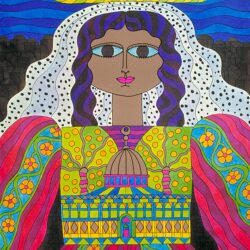Donor in the Spotlight: Herbert Flack

In addition to the fashion and costume collection, MoMu also houses a rich library collection. Archives on Belgian fashion are actively collected and we regularly receive donations. In the spotlight today: the personal archive of Mimi Peetermans, who designed sets and costumes for theatre and dance for four decades and taught costume history at (among others) Studio Herman Teirlinck. Thanks to husband Herbert Flack, her broad collection of reference materials found a new home at the MoMu Library.
Mimi Peetermans' oeuvre bears witness to a certain period in the history of theatre. When you talk about the past, it fades. Fortunately, paper artefacts live on.

People often refer to Mimi as 'Tante Ria', her role as one of the side kicks of 'Nonkel Bob'. Meanwhile, she was a true pioneer of scenography and costume design. Did that bother her?
HERBERT FLACK: "Mimi was not into PR, she rolled from one production to another. It was her great dream - in the late 1940s - to become a costume designer. Once she graduated from the Académie des Beaux Arts, she came under the wing of Herman Teirlinck. He felt that as a costume designer, you had to know what is was like to be an actor. So she enrolled in the acting course at the Studio. Then, slowly, she started at the KNS - there was no such thing as a costume designer or scenographer for theatre back then. She looked good and had a natural presence, which is how she ended up on TV - purely to make a living. She would wrap up a broadcast and take the train to the theatre; that was her real job. For the general public, that particular role has stuck; your history and achievements in the theatre fade with time, something I notice myself."
Why did you insist on donating her archive to MoMu?
HF: "I already contributed to an exhibition of her work twenty years ago. I feel a great deal of responsibility: it is such an extraordinary body of work that must absolutely be preserved. It also bears witness to a certain period in the history of theatre. When you talk about the past, it fades. Fortunately, paper artefacts live on. Mimi mastered her époques wonderfully well. From medieval to baroque, empire to renaissance, the designs flowed effortlessly from her pencil, following on from the programme at the KNS. By the 1960s, she had built up her own studio where she managed six seamstresses who created her costumes, tailored to the actors. It was magical, a lot handwork and fittings like you only see today with great couturiers. She studied pieces from a particular era and then reinterpreted them for the actors. Together with the directors, she worked on the design: how are we going to give a Molière or Shakespeare its own touch?"
A journalist from The New York Times wrote, 'It's a design with a perfume of Chanel'. This typifies the style 'Mimi Peetermans'.
What kind of books and documents are part of the donation?
HF: "Reference books on clothing from certain time periods - right down to the accessories, but also novels, educational materials, documents or books with historical paintings on which you can see the clothing... Anything and everything related to fashion and design. My library is filled with works that should not be lost, which I know will be in good hands at MoMu. I donated part of the oeuvre - costumes and sets - to the Letterenhuis. It might seem crazy, costumes in a literary archive, but many of those productions are linked to authors, hence their interest in preserving them. It really does something to me when I talk about this, as it also reflects a certain period in my life. And it was Mimi's passion, a passion that I enjoyed sharing. Moreover, I admire the way she was able to say goodbye to that career, after 43 years in the spotlight and having been given all those opportunities, with dignity when she became ill."
For you, they also hold emotional value. Are there pieces you can't part with?
HF: "For the time being, I will hold on to the sketches and designs. For each costume, I added the reference of the actor and the play. Authentic black-and-white photos of the performances show that they looked identical in real life. Next to the theatre, she created designs for dance performances, television and even film. Mimi worked closely with Jeanne Brabants of Ballet Van Vlaanderen. For 120 out of the 200 choreographies she created, Mimi designed the scenography and costumes herself. One of those performances was Grand Hôtel, set to music by Charlie Chaplin, a reference to an illustrious Hollywood hotel - frequented by all the big stars - truly top notch entertainment. Ballet Van Vlaanderen toured the U.S. with it, eventually bringing the performance to Broadway. A journalist from The New York Times wrote of Mimi's designs: 'It's a design with a perfume of Chanel'. That quote made her very proud and, of course, we used it afterwards. After all, that was the common thread through her work: it was always very refined, very feminine and very aesthetic. It typifies the style 'Mimi Peetermans'. Just a word about that Aunt Ria aura: I much prefer this quote." (laughs)

The library and archive collection is freely accessible. More info at momu.be/en/library


